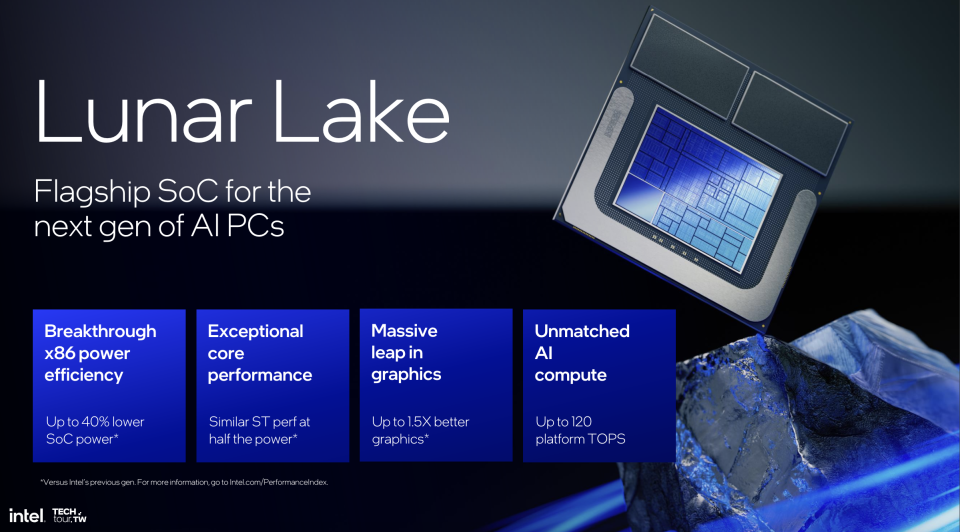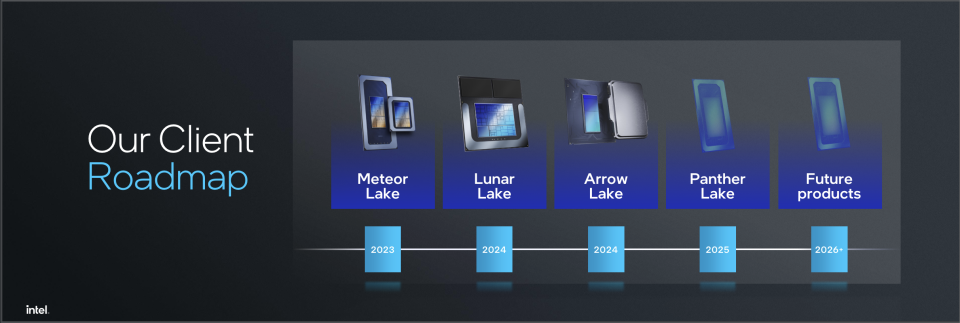In a stunning debut, Intel claims 3x better AI performance for its new Lunar Lake chips

Intel officially announced the Lunar Lake series of processors on Tuesday, confirming the early reports that the new AI silicon offers three times the NPU performance of its predecessors.
Intel announced the Lunar Lake chipsets (a follow-up to the 2023 Meteor Lake Intel Core Ultra processors) during a keynote speech at the Computex Taipei conference in Taiwan.
The presentation confirmed many of our high expectations for the chipset thanks to several leaks ahead of Tuesday's reveal. In addition to having over 100 TOPS (trillions of operations per second) of AI performance, the Lunar Lake chips also come with faster graphics, increased power efficiency, and increased core performance.
The impressive news from Intel comes as other major manufacturers, such as AMD, Nvidia, Qualcomm, and MediaTek, are also unveiling their latest hardware, with a major focus on AI. Next week, Apple is expected to dedicate much of its annual WWDC conference to AI.
Lunar Lake specs breakdown

Up to 40 percent lower SoC (System-on-a-Chip) power than Meteor Lake
Similar ST (steal time) performance at half-power over Meteor Lake
Up to 1.5x better graphics than Meteor Lake
Up to 120 TOPS of AI power across the platform
Up to 48 TOPS from the NPU
Up to 67 TOPS from the GPU
Up to 5 TOPS from the CPU

The Lunar Lake chips feature an eight-core hybrid design with a four-core efficient cluster and a four-core performance cluster. The efficient cores offer twice the vector and AI output over Meteor Lake chips and 4MB of shared L2 cache.
This is twice the low-power island (LPI) of the Meteor Lake chips, and all four efficiency cores are performance-capable. The performance cores offer better single-thread performance over Meteor Lake, 2.5MB of L2 cache per core, up to 12MB of shared L3 cache, and a PPA-optimized core design.
The Lunar Lake chipsets also feature an Xe2 GPU with increased power efficiency. The GPU comprises eight next-gen Xe2 cores, eight ray-tracing units, 8MB of cache, and XMX (Xe Matrix eXtensions) architecture for AI throughput. That means the Lunar Lake integrated Arc GPU offers up to 50 percent better graphics than the Meteor Lake chipset with real-time ray tracing and AI-based upscaling.
Finally, the Lunar Lake silicon offers new display, media, and imaging engines, supporting av1 encode and decode, VVC (versatile video coding) decode, DisplayPort and HDMI 2.1, eDP 1.5 low power port, multi-frame still processing, enhanced temporal noise reduction, and improved dual exposure staggered HDR.
Intel CPU roadmap

Intel also confirmed that the upcoming Arrow Lake CPUs will be shipping this year, likely sometime in the fall. Intel will also unveil the "Panther Lake" chipsets in 2025 with improvements over the Lunar Lake SoC.
What does this mean for the future of AI PCs?

AI PCs have accelerated staggeringly since the first AMD Ryzen 7000 series desktop chips launched with Ryzen AI NPUs in late 2022. The AI PC race to have the most TOPS of AI performance took off with Intel's Meteor Lake "AI PC" branding in late 2023 and has only gained traction ever since. However, TOPS is just one quick way to refer to NPU performance and may not be the most accurate representation of what a neural processor can do.
While we're still waiting to find a compelling case for why everyone needs on-device AI support, we expect chipmakers to continue improving their NPUs generation-over-generation in a constant arms race to determine who can cram the most TOPS into their silicon.
So, while Intel may be the first to hit over 100 TOPS of performance, AMD and Qualcomm will likely work to be sure they can beat that 120 TOPS benchmark on their next round of chipsets.
